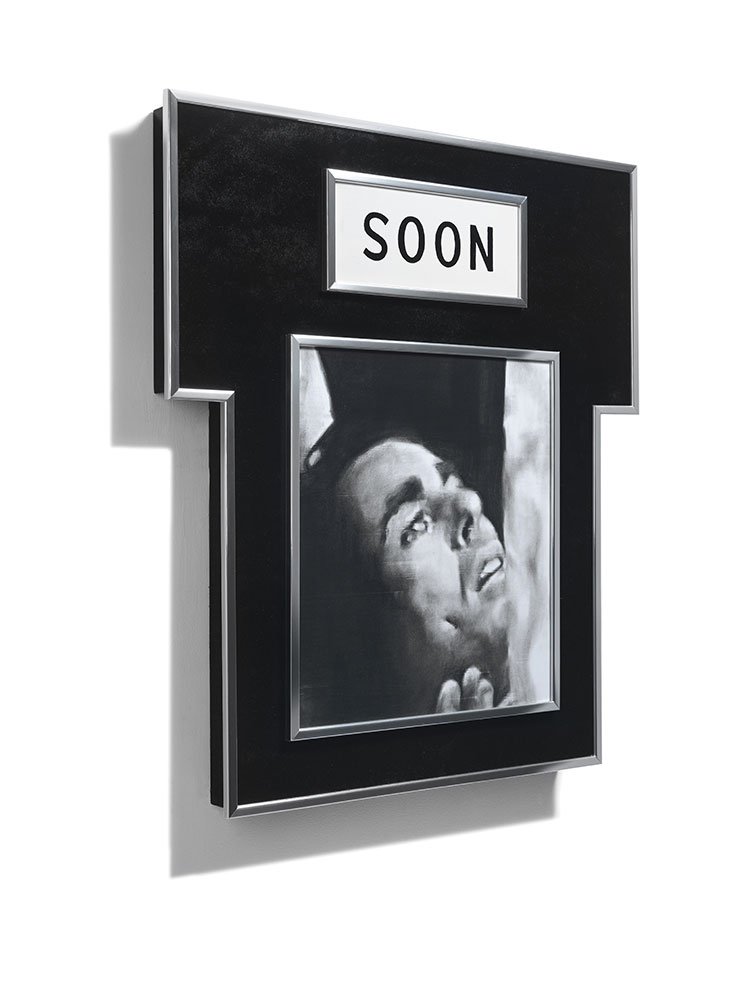-
In Fowler’s work, framing is never considered merely as a secondary feature or a finishing touch, instead it is intrinsic to the work itself. The three cyclical images of Soon are all different, but their frames follow a single theme: they are based on cinema hoardings placed at the entrance to movie theatres during the 1930s to advertise the actors and actresses ‘soon’ to be starring in forthcoming productions. In this sense, they mobilise Fowler’s enthusiasm for merging the two- and three-dimensional planes. These hoardings would typically be painted in pastel shades, redolent of the era’s soft-focus aesthetics. Fowler, however, renders the frames in black, with the word “soon” itself hand-painted in black lead. She hired a traditional sign-writer to ensure that the replica hoardings were emphatically authentic. Reminiscent of altarpieces or even gravestones, Fowler’s trio of images transmutes this sense of expectation into something altogether more sinister than an anticipated Hollywood release.
Soon: Johnnie Ray
“I always felt his ‘crying’ act was deeply rooted in the rebellious revolution to come.” - Nina Mae Fowler The first image in the Soon series is a representation of the 1950s singer and songwriter Johnnie Ray. Infamous for his on-stage theatrics, Ray was well known for falling dramatically to the floor and tearing at his hair. Crying as his performance progressed became a trademark feature of shows. As a teen idol he prompted hysterical receptions at concerts, particularly among female fans. He is widely credited with being the forefather of modern Rock and roll, and unquestionably had an enormous influence on his friend Elvis Presley. Some claim that as Elvis’s stardom rose, Johnnie Ray became an overshadowed hero, his career dogged by rumours of homosexuality and arrests for solicitation. In her sensitive rendition of this obscured star, Fowler captures and pays tribute to the singer using footage of him weeping uncontrollably during a performance.Soon: Death of Paquirri.
Bullfighting has an enduring, magnetic allure for Fowler. This work depicts the legendary bullfighter Francisco Rivera Perez, commonly known as Paquirri. Paquirri reached unprecedented, frenzied levels of stardom in Spain, with his leading-man looks and technical skill in the ring. But in 1984, at the age of 36, he was gored by a bull in Pozoblanco and died before making it to hospital. The fight was one of the first to be televised, capturing his unexpected agonies and etching his legend into the collective memory. Fowler has rendered the harrowing incident by extracting a still from footage recorded in the moments before the bullfighter’s death, while attendants frantically sought to salve his dreadful wounds. The scene ripples with its subject’s fearful gaze. As Fowler puts it, there is a fittingly romantic and oddly cinematic tone to the scene, with Paquirri’s “dimple reminiscent of his wounds as well as a symbol of his Hollywood good looks”.Soon: Une Femme Mariée
This image of a silhouetted male is based on a scene from Jean Luc Godard’s 1964 film Une Femme Mariée. In the scene, a married couple are arguing over the wife’s behaviour. A chase between husband and wife ensues, framed within the confines of their apartment. Godard films the whole scene from the fixed viewpoint of a balcony above the apartment, situating the viewer in a voyeuristic relation to the couple. Fowler’s work deftly captures this transgressive, slightly prurient sensation. Choosing to freeze-frame the moment that the male character leaps through the window in his pyjamas and extricating it from its context, she renders the image both menacing and mysterious. The figure’s faceless, looming silhouette generates an ambiguous atmosphere of escape and pleasure, laced with uncertainty and tension. She ensures that this sense leaks from the scene itself and into the viewer’s self-consciousness.
Featured in Measuring Elvis, 2015
Read further writing and essays in response to the subjects and themes relating to the work of Nina Mae Fowler here.





